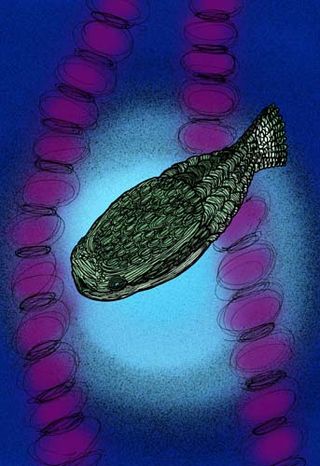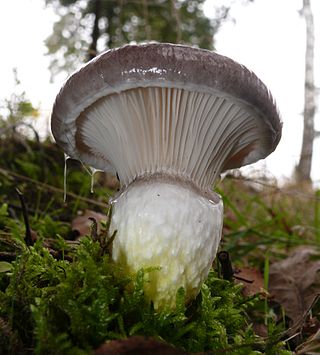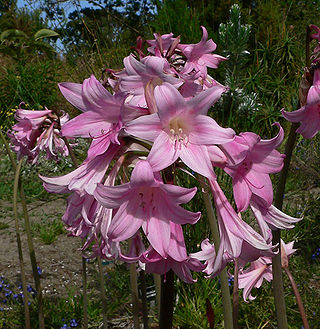In biology, a monotypic taxon is a taxonomic group (taxon) that contains only one immediately subordinate taxon. A monotypic species is one that does not include subspecies or smaller, infraspecific taxa. In the case of genera, the term "unispecific" or "monospecific" is sometimes preferred. In botanical nomenclature, a monotypic genus is a genus in the special case where a genus and a single species are simultaneously described. In contrast, an oligotypic taxon contains more than one but only a very few subordinate taxa.

Ornithogalum is a genus of perennial plants mostly native to southern Europe and southern Africa belonging to the family Asparagaceae. Some species are native to other areas such as the Caucasus. Some species are classified as noxious invasive weeds in some portions of North America. Growing from a bulb, species have linear basal leaves and a slender stalk, up to 30 cm tall, bearing clusters of typically white star-shaped flowers, often striped with green. The common name of the genus, star-of-Bethlehem, is based on its star-shaped flowers, after the Star of Bethlehem that appears in the biblical account of the birth of Jesus. The number of species has varied considerably, depending on authority, from 50 to 300.

Heterostraci is an extinct subclass of pteraspidomorph, Ostracoderm, jawless vertebrate that lived primarily in marine and estuary environments. Heterostraci existed from the mid-Ordovician to the conclusion of the Devonian.

Tolypelepidida is an extinct order of heterostracan vertebrates. These armored jawless fish superficially resemble their relatives, the cyathaspids, though, researchers place the tolypelepids as a sister group to the cyathaspids and the pteraspidids. A recent study by Lundgren and Blom in 2013 implies that the order is paraphyletic, with the type genus, Tolypelepis, being the sister taxon of Cyathaspidiformes. The typical tolypelepid had a carapace formed from dorsal and ventral plates, and a scaly tail.

Gomphidius is a genus of mushrooms, commonly known as spike-caps, that are members of the Boletales, or pored fungi. They appear to have gill-like structures which resemble those of agarics, however the similarity is superficial only. The best-known member is the slimy spike-cap. The genus has a widespread distribution, especially in north temperate areas, and contains 10 species.

Drepanosaurs are a group of extinct reptiles that lived between the Carnian and Rhaetian stages of the late Triassic Period, approximately between 230 and 210 million years ago. The various species of drepanosaurs were characterized by a bird-like skull, a barrell shaped body, and a horizontally narrow tail. A number of drepanosaurs had specialized grasping limbs and often prehensile tails similar to those of chameleons. Drepanosaurs are generally thought to have been arboreal (tree-dwelling), and probably insectivores. Some studies have alternately suggested fossorial (digging) and aquatic lifestyles for some members. Fossils of drepanosaurs have been found in North America and Europe. The name is taken from the family's namesake genus Drepanosaurus, which means "sickle lizard," a reference to their strongly curved claws.

The danionins are a group of small, minnow-type fish belonging to the family Cyprinidae. Species of this group are in the genera clades Danio and Devario, based on the latest phylo-genetic research by Fang et al in 2009. They are primarily native to the fresh waters of South and Southeast Asia, with fewer species in Africa. Many species are brightly coloured and are available as aquarium fish worldwide. Fishes of the danio clade tend to have horizontal stripes, rows of spots, or vertical bars, and often have long barbels. Species within the devario clade tend to have vertical or horizontal bars, and short, rudimentary barbels, if present at all. All danionins are egg scatterers, and breed in the rainy season in the wild. They are carnivores, living on insects and small crustaceans.

Amaryllidoideae is a subfamily of monocot flowering plants in the family Amaryllidaceae, order Asparagales. The most recent APG classification, APG III, takes a broad view of the Amaryllidaceae, which then has three subfamilies, one of which is Amaryllidoideae, and the others are Allioideae and Agapanthoideae. The subfamily consists of about seventy genera, with over eight hundred species, and a worldwide distribution.
Alamodactylus is an extinct genus of pteranodontian pterosaur known from the Late Cretaceous of Texas, southern United States. It contains a single species, Alamodactylus byrdi.

Pteraspidiformes is an extinct order of heterostracan agnathan vertebrates known from extensive fossil remains primarily from Early Devonian strata of Europe and North America, and from Upper Silurian Canada.

Cyathaspidiformes is an extinct order of heterostracan vertebrates known from extensive fossil remains primarily from Silurian to Early Devonian strata of Europe, and North America, and from Early Devonian marine strata of Siberia.

Amphiaspidida is a taxon of extinct cyathaspidid heterostracan agnathans whose fossils are restricted to Lower Devonian marine strata of Siberia near the Taimyr Peninsula. Some authorities treat it as a suborder of Cyathaspidiformes, while others treat it as an order in its own right as "Amphiaspidiformes." In life, they are thought to be benthic animals that lived most of their lives mostly buried in the sediment of a series of hypersaline lagoons. Amphiaspids are easily distinguished from other heterostracans in that all of the plates of the cephalothorax armor are fused into a single, muff-like unit, so that the forebody of the living animal would have looked like a potpie or a hot waterbottle with a pair of small, or degenerated eyes sometimes flanked by preorbital openings, a pair of branchial openings for exhaling, and a simple, slit-like, or tube-like mouth.
Siberiaspidoidei is a taxon of extinct amphiaspidid heterostracan agnathans whose fossils are restricted to Lower Devonian marine strata of Siberia near the Taimyr Peninsula. In life, siberiaspids are thought to be benthic animals that lived most of their lives mostly buried in the sediment of a series of hypersaline lagoons. As with all amphiaspids, siberiaspids are easily distinguished from other heterostracans in that all of the plates of the cephalothorax armor are fused into a single, muff-like unit, so that the forebody of the living animal would have looked like a flattened potpie or a hot waterbottle with a pair of small, or degenerated eyes sometimes flanked by preorbital openings, a pair of branchial openings for exhaling, and a simple, slit-like, or tube-like mouth.

Anglaspis is an extinct genus of cyathaspidiform heterostracan agnathan. Fossils are found in marine strata of Europe, from the late Silurian period until the genus' extinction during the Early Devonian. As with other cyathaspidiforms, individuals of Anglaspis had dorsal and ventral plates covering the forebody, gill pouches, and nasal openings that lay on the roof of the oral cavity.

Paraliliaspis egregia is an extinct cyathaspidiform heterostracan agnathan from early Devonian marine strata of the Ural Mountains.

Turridae is a taxonomic family name for a number of predatory sea snails, marine gastropod mollusks in the superfamily Conoidea.

Cyathaspididae is an extinct family in the heterostracan order Cyathaspidiformes.

Ctenaspidae is a family of extinct cyathaspidiform heterostracan agnathans in the suborder Cyathaspidida.

Ariaspidae is a family of extinct cyathaspidiform heterostracan agnathans in the suborder Cyathaspidida.

Aloeae is a tribe of succulent plants in the subfamily Asphodeloideae of the family Asphodelaceae, consisting of the aloes and their close relatives. The taxon may also be treated as the subfamily Alooideae by those botanists who retain the narrower circumscription of Asphodelaceae adopted prior to the APG III system. Typically, plants have rosettes of more or less succulent leaves, with or without a distinct stem. Their flowers are arranged in racemes and tend to be either small and pale, pollinated by insects, or larger and more brightly coloured, pollinated by birds. As of 2017, 11 genera are recognized, most created since 2010 by splitting off another five genera from Aloe and another two from Haworthia. Only two genera, Aloe and Aloidendron, are native outside southern Africa, extending northwards to the Arabian Peninsula. Seven genera are restricted to South Africa, some with small ranges. Members of the Aloeae are cultivated by succulent plant enthusiasts; Aloe species especially are used in temperate climates as ornamental garden plants. Some species are used in traditional medicine. Aloe vera and Aloe ferox are cultivated for their extracts, whose uses include moisturizers and emollients in cosmetics.

















